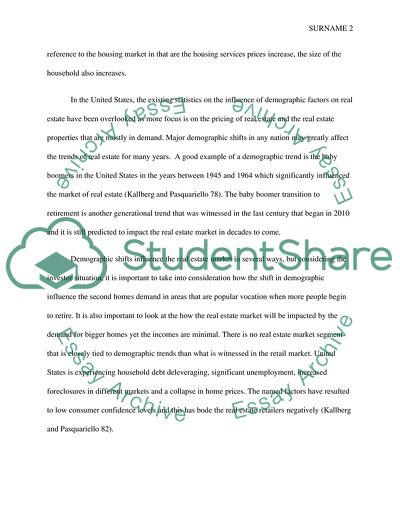
- Home
- Free Samples
- Premium Essays
- Editing Services
- Extra Tools
- Essay Writing Help
- About Us
- Studentshare
- Subjects
- Miscellaneous
- Demographic factors influencing the real estate markets
Demographic factors influencing the real estate markets - Essay Example

- Subject: Miscellaneous
- Type: Essay
- Level: Undergraduate
- Pages: 4 (1000 words)
- Downloads: 0
- Author: blandamissouri
Extract of sample "Demographic factors influencing the real estate markets"
This has however been considered as being an oversimplification as there are other factors that have to be taken into consideration such as the family age composition, the size of the family, net migration, divorce rates, death rates and marriages. When it comes to housing economics, the analysis of unit element is not based on an individual is it is done in models of standardized partial equilibrium. They are the households that result in housing service demand, that is, one household for every house.
The demographic composition and the size of households have been identified as being variables and not completely exogenous (Bardgan and Tsang 2). They only happen to be endogenous with reference to the housing market in that are the housing services prices increase, the size of the household also increases. In the United States, the existing statistics on the influence of demographic factors on real estate have been overlooked as more focus is on the pricing of real estate and the real estate properties that are mostly in demand.
Major demographic shifts in any nation may greatly affect the trends of real estate for many years. A good example of a demographic trend is the baby boomers in the United States in the years between 1945 and 1964 which significantly influenced the market of real estate (Kallberg and Pasquariello 78). The baby boomer transition to retirement is another generational trend that was witnessed in the last century that began in 2010 and it is still predicted to impact the real estate market in decades to come.
Demographic shifts influence the real estate market in several ways, but considering the investor situation, it is important to take into consideration how the shift in demographic influence the second homes demand in areas that are popular vocation when more people begin to retire. It is also important to look at the how the real estate market will
...Download file to see next pages Read MoreCHECK THESE SAMPLES OF Demographic factors influencing the real estate markets
Different Age Demographics
Analysis of Canbide
The Impact of social Networking on Customer Loyalty
Comparison of Property Market between Malaysia and China
Waste Management Incorporation
Real Estate Economics
Occupational Health Challenges in the United Kingdom
Process of the Russian Real Estate Purchase

- TERMS & CONDITIONS
- PRIVACY POLICY
- COOKIES POLICY